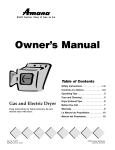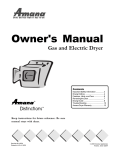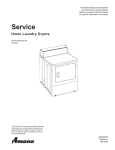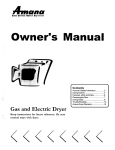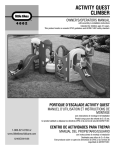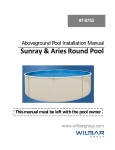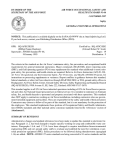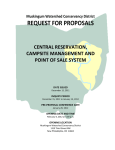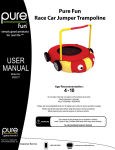Download SDE/G4000 Auto Dry Dryer-1
Transcript
AUTO DRY DRYER SDE/G4000 ® Introduction Page 1 Safety NOTE: In our continuing effort to improve the quality of our appliances, it may be necessary to make changes to the appliance without revising this guide. IMPORTANT: Keep this guide and the sales receipt in a safe place for future reference. Proof of original purchase date is needed for warranty service. Pages 2 Controls Pages 3-4 Operating tips Pages 5-6 Care and cleaning Pages 6-7 Laundry tips Pages 8-9 IMPORTANT: For service and warranty information, see page 11. Before you call Warranty A/09/01 Part No. 40139101 http://www.maytag.com Pages 9-10 Page 11 MCS No. 22003711 Litho U.S.A. THANK YOU FOR BUYING A MAYTAG DRYER! Please take the time to complete the registration card and return promptly. If registration card is missing, call Maytag Customer Assistance. When contacting Maytag, provide product information from serial plate found on upper right-hand corner of door opening: Model Number _______________________________________________________ Serial Number (S/N) ___________________________________________________ Purchase Date _______________________________________________________ Dealer Name ________________________________________________________ Dealer Address _______________________________________________________ Dealer Phone ________________________________________________________ Keep this manual and your sales receipt together in a safe place for future reference or if warranty service is required. For additional questions, please contact us: Maytag Appliances Sales Company, 1-800-688-9900 USA, 1-800-688-2002 Canada, 1-800-688-2080 USA TTY (for deaf, hearing impaired or speech impaired) Mon.-Fri., 8am-8pm Eastern Time; Internet: http://www.maytag.com. For more information on this and other Maytag products, visit our Web site www.maytag.com or call Maytag Customer Assistance at 1-800-688-9900 (U.S.A.) 1-800-688-2002 (Canada) 1-800-688-2080 (TTY U.S.A. Only) What you need to know about safety instructions Warning and Important Safety Instructions appearing in this manual are not meant to cover all possible conditions and situations that may occur. Common sense, caution, and care must be exercised when installing, maintaining, or operating dryer. Always contact your dealer, distributor, service agent, or manufacturer about problems or conditions you do not understand. Recognize safety symbols, words, labels DANGER DANGER – Immediate hazards which WILL result in severe personal injury or death. WARNING WARNING – Hazards or unsafe practices which COULD result in severe personal injury or death. CAUTION CAUTION – Hazards or unsafe practices which COULD result in minor personal injury or product or property damage. 1 Parts and accessories Purchase replacement parts and additional accessories by phone. To order accessories for your Maytag product, call 1-800-688-9900 inside U.S.A., 1-800-688-2080 for U.S. customers using TTY for deaf, hearing impaired or speech impaired or 1-800-688-2002 for Canada. Save time and money If something seems unusual, please check “Before you Call” section, which is designed to help you solve problems before calling service. If you have a question, write or call us (include model number and phone number) at: Maytag Appliances Sales Company Attn: CAIR® Center P.O. Box 2370 Cleveland, TN 37320-2370 U.S. 1-800-688-9900 Canada 1-800-688-2002 U.S. customers using TTY for deaf, hearing impaired or speech impaired, call 1-800-688-2080. WARNING: For your safety, the information in this manual must be followed to minimize the risk of fire or explosion or to prevent property damage, personal injury or death. –Do not store or use gasoline or other flammable vapors and liquids in the vicinity of this or any other appliance. –WHAT TO DO IF YOU SMELL GAS • Do not try to light any appliance. • Do not touch any electrical switch. • Do not use any phone in your building. • Clear the room, building or area of all occupants. • Immediately call your gas supplier from a neighbor’s phone. Follow the gas supplier’s instructions. • If you cannot reach your gas supplier, call the fire department. Installation and service must be performed by a qualified installer, service agency or the gas supplier. IMPORTANT SAFETY INSTRUCTIONS WARNING: To reduce risk of fire, electric shock, serious injury, or death when using your dryer, follow basic precautions, including the following: 1. Read all instructions before using the appliance. 2. To avoid the possibility of fire or explosion: a. Do not dry items that have been previously cleaned in, washed in, soaked in, or spotted with gasoline, dry-cleaning solvents, other flammable or explosive substances as they give off vapors that could ignite or explode. Any material on which you have used a cleaning solvent, or which is saturated with flammable liquids or solids, should not be placed in the dryer, until all traces of these flammable liquids or solids and their fumes have been removed. There are many highly flammable items used in homes, such as: acetone, denatured alcohol, gasoline, kerosene, some liquid household cleaners, some spot removers, turpentine, waxes and wax removers. b. Items containing foam rubber (may be labeled latex foam) or similarly textured rubber-like materials must not be dried on a heat setting. Foam rubber materials when heated, can under certain circumstances produce fire by spontaneous combustion. 3. Do not allow children or pets to play on, in, or in front of the appliance. Close supervision is necessary when the appliance is used near children and pets. 4. Before the appliance is removed from service or discarded, remove the door to the drying compartment. 5. Do not reach into the appliance if the drum is moving. 6. Do not install or store this appliance where it will be exposed to the weather. 7. Do not tamper with controls. 8. Do not repair or replace any part of the appliance or attempt any servicing unless specifically recommended in published user-repair instructions that you understand and have the skills to carry out. 9. Do not use fabric softeners or products to eliminate static unless recommended for dryer use by the manufacturer of the fabric softener or product. 10. Clean the lint screen before or after each load. 11. Keep the area around the exhaust opening and surrounding areas free from lint accumulation, dust and dirt. 12. The interior of the dryer and exhaust duct should be cleaned periodically by qualified service personnel. 13. This appliance must be properly grounded. Never plug the appliance cord into a receptacle which is not grounded adequately and in accordance with local and national codes. See installation instructions for grounding this appliance. 14. Do not sit on top of the clothes dryer. WARNING: To reduce riskyour of dryer fire, items electric Do not place into that shock, injury, death have beenserious spotted or soakedorwith vegwhen using your dryer, follow etable oil or cooking oil. Even after being washed, these items may contain basic precautions, including the significant amounts of these oils. The following: remaining oil can ignite spontaneously. The potential for spontaneous ignition increases when the items containing vegetable oil or cooking oil are exposed to heat. Heat sources, such as your clothes dryer, can warm these items, allowing an oxidation reaction in the oil to occur. Oxidation creates heat. If this heat cannot escape, the items can become hot enough to catch fire. Piling, stacking or storing these kinds of items may prevent heat from escaping and can create a fire hazard. All washed and unwashed fabrics that contain vegetable oil or cooking oil can be dangerous. Washing these items in hot water with extra detergent will reduce, but will not eliminate, the hazard. Always use the “cool down” cycle for these items to reduce the items’ temperature. Never remove these items from the clothes dryer hot or interrupt the drying cycle until the items have run through the “cool down” cycle. Never pile or stack these items when they are hot. California Safe Drinking Water and Toxic Enforcement Act (Proposition 65)—Gas Dryers Only The Governor of California is required to publish a list of substances known to the state of California to cause cancer or reproductive harm and requires business to warn customers of potential exposures to such substances. Gas appliances contain or produce substances which can cause death or serious illness and which are known to the State of California to cause cancer, birth defects, or other reproductive harm. To reduce the risk from substances in fuel or from fuel combustion, make sure this appliance is installed, operated, and maintained according to the manufacturer’s instructions. SAVE THESE INSTRUCTIONS FOR FUTURE REFERENCE 2 CONTROLS AT A GLANCE Select temperature setting LOAD TYPE Step 1 Set TEMPERATURE setting knob to most appropriate temperature for type of fabric in load. Follow garment manufacturer’s care label for recommended temperature settings. See chart to the right. MEDIUM EXTRA LOW AIR FLUFF REGULAR REGULAR (approximately 160° F): Use for sturdy items like play or work clothes. MEDIUM (approximately 150° F): Use for permanent press and synthetic items. EXTRA LOW (approximately 129° F): Use for delicate items. AIR FLUFF (no heat): Use for sensitive loads or items needing freshening. TEMPERATURE Time Dry cycle can be used with all Temperature settings. Step 2 Select ‘signal’ volume OFF LOUD If a volume level is selected, the signal will let you know when the cycle is done. Signal will stop when the door is opened, or when the timer is advanced to an OFF position. SIGNAL Select ‘press care’, if desired Step 3 On Auto Dry only, PRESS CARE helps to reduce wrinkling after the normal drying cycle. After COOL DOWN portion of the cycle, it continues to tumble clothes without heat for 40 minutes, until the dryer door is opened, or the switch is turned to the OFF position. 3 ON OFF PRESS CARE Step 4 Select desired setting Push in timer knob to start. To stop dryer at any time, AUTO DRY cycles will automatically determine the time needed to dry your clothes and will work on any TEMPERATURE setting. Set the timer for the type of fabric in the load. open door or turn timer knob to the OFF position. To restart dryer, close door, reset timer if necessary, and push in the timer knob. WRINKLE RELEASE cycle helps remove wrinkles from slightly wrinkled items that may have been sitting in a dryer or laundry basket overnight. The cycle has a short heat setting followed by a 5-minute COOL DOWN. TIME DRY cycle will operate dryer for up to 75 minutes. Cottons and heavyweight items dry best between 50 and 75 minutes, lightweight items dry best between 20 and 40 minutes. 4 OPERATING TIPS Sort clothes for drying Properly dried clothes will need a minimum of care when removed from the dryer. Clothes properly sorted for washing should be properly sorted for drying also. Follow the examples below. DARK AND LIGHT COLORS: Separate light clothes from dark clothes. LINT-RECEIVING FABRICS: Corduroys, knits (including socks), permanent press and synthetics. HEAVY AND LIGHTWEIGHT FABRICS: Lightweight fabrics dry faster than heavyweight fabrics. If mixed loads are dried together (such as sheets and towels), remove the lighter weight fabrics when they are dry to prevent over drying and wrinkling. LINT-SHEDDING FABRICS: Towels, flannels, chenille, cottons, rugs. Clean the lint filter before each use A clean lint filter ensures efficient drying and clothes will remain lint-free when unloading dryer. A layer of lint on the screen will reduce air flow through the dryer and lengthen drying time. Lint screen may be washed if needed. • Lint filter is located at front of the dryer in the lower part of door opening. Optional drying rack Drying rack is useful for drying items that require no tumble drying, such as tennis shoes, sweaters, stuffed toys or other delicate items. See your Maytag dealer for details. 5 • Replace lint filer in door recess and push in firmly. Words on filter should face front of dryer. • Add clothes loosely into dryer drum. Add fabric softener sheet, if desired. • Close loading door. Dryer will not operate with the door open. IMPORTANT: Lint filter must be in place in door opening when using dryer or loading and unloading dryer. If filter is not in place, clothing could fall into front air duct. LINT FILTER Drying times • Installation (length of exhaust duct, etc.). It is impossible to give exact drying times. Conditions from home to home vary and directly affect drying times. The length of time it takes to dry loads will depend on several variables. • Load size. • Electric voltage or gas pressure. • Type of fabric, washer and spin speed will determine moisture in the fabric. • Heat and moisture in the room. Damp air coming into the dryer will increase drying time. If you have an automatic cycle, you need not worry about time. The automatic cycle will determine the time needed. Here are some important items to remember: • In some models, the automatic cycle does not operate as a timed cycle. While using this feature, the cycle dial advances as the clothes dry. The dial may advance slowly or quickly depending on the moisture content of the clothes. • Do not set the timer for a “higher” setting than necessary. If you have a permanent press/knit cycle, use it for loads of permanent press, knits, and for clothes made from, or containing synthetic fibers. This cycle has a longer COOL DOWN period at the end of the cycle to reduce wrinkling. CARE AND CLEANING Cleaning How to Remove Ball Point Pen Ink Marks from the Dryer Drum Exhaust system • Ordinarily, dryer cylinder will need no care. • If the ink stain is fresh, place dry rags in the dryer. Using the hottest heat setting, run the dryer for one hour to absorb the ink. • The exhaust duct should be inspected after one year of use and cleaned if necessary. Inspect and clean exhaust duct every one to two years as required thereafter. • If the stain is not fresh, apply household spray or cream cleaner to a soft cloth, and rub the stain. Then, place wet rags in the dryer. Using the hottest heat setting, run the dryer for one hour to remove any cleaner residue. • The weather hood should be checked frequently to make sure the dampers move freely, dampers are not pushed in and that nothing has been set against them. • Wipe dryer cabinet as needed. If detergent, bleach or other washing products have been spilled on the dryer, wipe immediately. Some products will cause permanent damage if spilled on the cabinet. • Do not allow sharp or rough objects to lean against the dryer. The finish could be damaged. • Use only a damp or sudsy cloth for cleaning the control panel. Some spray prewash products may harm the finish on the control panel. Lubrication All moving parts are sealed in a permanent supply of lubricant or are equipped with oilless bearings. Additional lubrication will not be necessary. • Keep dryer area clear and free from combustible materials, gasoline and other flammable vapors and liquids. • Do not obstruct the flow of combustion (gas dryers) and ventilation air. 6 CARE AND CLEANING CONT. Reversing the door Follow these steps to reverse the door: 1. Remove four hinge-attaching screws. 2. Remove all nine screws from door and hinges. 3. Pull bottom of door liner out (A), then pull down (B), removing door liner from door panel. 1 4. Rotate door panel 180° as shown. 5. Remove door strike from door liner and reinstall on opposite side. 6. Insert liner under flange on bottom of door (A), then push top of door liner into place (B). 8. Using screwdriver, remove two door plugs and reinstall on opposite side of door opening. 9. Reinstall four hinge attaching screws removed in Step 1. 7. Reinstall nine screws removed in Step 2. 2 3 B A 4 5 6 B A 7 7 8 9 SPECIAL LAUNDRY TIPS Please follow the care label or manufacturer’s instructions for drying special items. If care label instructions are not available, use the following information as a guide. Bedspreads Blankets Choose heat for the type fabric used. Dry one double or two single spreads at once. (Chenille and tufted spreads will shed lint and should be dried along. New spreads will contain loose lint.) Tumble new spreads on AIR FLUFF setting before washing to remove loose lint. (These spreads may be dried completely.) Electric DELICATE or AIR FLUFF cycles. If the manufacturer recommends drying the blanket in the dryer, follow the “Wool” instructions below. Do not stretch the blanket because of the wiring. Some electric blankets may have insulation on the thermostats or on the wiring which will not withstand dryer heat. Do not dry in dryer unless the blanket manufacturer says it can be done. Synthetic Fibers DELICATE or AIR FLUFF cycles. Some of these blankets are fluffy and will shed lint. Tumble on AIR FLUFF setting before washing to remove loose lint. Use a gentle wash method, then dry in dryer until just dry. The lint filter may need to be cleaned during the drying. Thermal Cotton AUTO DRY REGULAR cycle. Wool Agitation and tumbling contribute to the shrinkage and felting of wool. We cannot guarantee that wool will not shrink. However, if care is taken and the blanket manufacturer’s instructions are followed,satisfactory results should be obtained. Wash by the soak method with as little agitation as possible. After washing, stretch blanket gently in both directions. Use approximately five dry bath towels and place them between folds in blanket. This will "cushion” it to lessen the tumbling. Set dryer for 20 minutes on the TIME DRY cycle. Use REGULAR heat setting, if it is available on your dryer. Check blanket when timer reaches 10. Wool blankets must be removed from the dryer when damp. Stretch gently to shape and finish drying over two clotheslines or in a flat position. Quilts Choose heat and cycle for fabric. Filling and cover must be completely washable. Old quilts may be too fragile to machine wash or dry. Quilts filled with cotton may become lumpy. Quilting should be close together. Remove from dryer slightly damp and stretch gently to shape. Quilted articles may shrink if over dried. Mattress Pads Material in mattress pads is made of either cotton or synthetic fibers. Read fiber content label, found on your mattress pad, to determine what type of fiber was used to manufacture the pad. READ AND CAREFULLY FOLLOW the fabric care instructions supplied by the mattress pad manufacturer. Some pads made of synthetic fibers are very heat sensitive. These pads can be flammable if over-heated or over-dried. TO AVOID A FIRE HAZARD, DO NOT OVER-DRY mattress pads. Remove pads from the dryer while they are still damp. Slip Covers Choose heat for fabric. Close zippers. Dry one couch cover, two chair covers or five or six pillow covers at one time. Remove from dryer when slightly damp. Press pleats if necessary and replace on furniture immediately. Stretch fabrics and knits should be dried completely so they will fit snugly when replaced on furniture. Pillows Curtains Draperies Feather and Down-Filled Ticking must be strong and seams secure. If in doubt, sew pillow into a case or use a zippered pillowcase to prevent feathers from coming out. After washing, shake pillow to fluff feathers. Dry one large or two smaller pillows. Use TIME DRY cycle. Use LOW or MEDIUM heat setting if it is available on you dryer. Shake and reposition pillows several times during drying. Pillows must be dry in the center to prevent mildew. Drying may take two hours or longer. Reset dryer timer if necessary. The odor of wet feathers is not pleasant. However, the odor will disappear once the pillows dry. Fiber-Filled (polyester) Follow manufacturer’s directions. Foam Rubber Do not dry in the dryer. Cotton AUTO DRY REGULAR or TIME DRY cycles. Remove damp items for ironing or dry completely, then steam iron. Fiberglass DO NOT DRY IN THE DRYER unless recommended by the manufacturer. Fiberglass may shred. Particles may remain in the dryer and rub off on the next load. This could irritate the skin. “Beta” fiberglass may be dried in the dryer if recommended by the manufacturer. Synthetic Fibers DELICATE or AIR FLUFF cycles. Allow room for tumbling to prevent wrinkling. Delicate or sheer curtains must be dried by themselves so they will not be snagged by hooks or crushed by other clothes in the load. Some sheer curtains are heat sensitive. Dry 10 minutes only, plus the cool down period. Remove from dryer immediately and hang. If the dryer has been heated from a previous load, AIR FLUFF setting may be sufficient. Remove hooks and weights before washing. Choose heat for fabric and allow space in the dryer for tumbling. Some draperies may be removed when slightly damp and hung immediately. Lined draperies should be dry-cleaned because they have a tendency to pucker. 8 SPECIAL LAUNDRY TIPS CONT. Knit Articles Lingerie All Knits Knit fabrics are usually manufactured under tension (stretching). Cotton knits especially may relax or draw together if every bit of moisture is removed form them. It is best to take them out of the dryer with a trace of moisture remaining, then stretch to shape. If they do shrink from over drying, rewet them and dry properly. Cottons AUTO DRY REGULAR or TIME DRY cycle. Remove slightly damp to minimize ironing. Reshape, smooth seams and pockets, etc. Synthetic Fibers (nylon, orlon, polyester, etc.) AUTO DRY REGULAR or AUTO DRY WRINKLE FREE FABRICS cycle. Turn inside out to prevent “pilling” (rolling up of the fiber ends from friction). Dry sweaters only with similar things because they tend to attract lint. Make sure the load is large enough for tumbling. Dry completely and remove from dryer immediately to minimize wrinkling. Wool DELICATE or AIR FLUFF cycle. For wool labeled “machine washable” follow manufacturer’s directions. For other wool, use wool blanket method. Do not dry loosely knit wool or hand knits. Dry these flat and stretch to shape from a pattern drawn before washing. Cotton AUTO DRY REGULAR cycle. Elastic Body oils can cause elastic to deteriorate. Wash garments containing elastic frequently. Elastic in such things as shorts may be dried, however avoid over drying. Foam Rubber Bras, bathing suits, sun suits, etc, DO NOT DRY THESE ITEMS IN THE DRYER WITH HEAT, FIRE MAY RESULT. AIR FLUFF setting may be used. Stretch Fabrics Choose heat for the most delicate fiber. These may be dried completely as they will stretch into shape. Avoid drying with lint-shedding fabrics. Synthetic Fibers TIME DRY cycle. Use a DELICATE or AIR FLUFF setting, if it is available on dryer. Some sheer fabrics, especially sheer knits, can be heat sensitive. Dry these until they are just dry (about 10 minutes) and remove from dryer immediately. Sheer fabrics should not be washed and dried with garments containing hooks or zippers. Synthetic fabrics will create static electricity if over dried. TO prevent this, use fabric softener and avoid over drying. Denim, Corduroy Rugs AUTO DRY REGULAR cycle. Dry completely and remove from dryer when seams are slightly wet to minimize shrinkage. Cotton with Cotton Backing AUTO DRY REGULAR or TIME DRY cycles. Dry one large or several small rugs. For one small rug only, add towels for buffers. Rubber-backed Hot water and heat tend to deteriorate many types of rubber. Some types of rubber-like materials are flammable under certain conditions. DO NOT DRY FOAM RUBBER AND RUBBER-LIKE MATERIALS WITH HEAT. Synthetic Fibers DELICATE or AIR FLUFF cycles. Follow manufacturer’s suggestions. Some of these rugs are heat sensitive and should be removed from the dryer when damp or dried with no heat. Stuffed Animals and Toys Make sure the filling and covering is washable and can be dried in the dryer. Cotton filling may become lumpy. Protect glass eyes by covering with a stocking or tie toy into a pillowcase. Choose heat for most sensitive fiber. Dry enough clothes in the load for good tumbling. DO NOT DRY TOYS STUFFED WITH FOAM RUBBER OR KAPOK IN THE DRYER WITH HEAT. Tennis Shoes DELICATE or AIR FLUFF cycle. Use a drying rack or tumble with at least four old bath towels. BEFORE YOU CALL You may save time and money by checking items below before calling for service. List includes common concerns that are not the result of defective workmanship or materials. TOPIC POSSIBLE CAUSE SOLUTION NOISE Vibrating Noise Dryer may not be resting firmly on floor. Some vibration is normal. Adjust leveling legs so dryer rests firmly on floor. See Installation Instructions for leveling details. Thumping, rattling or clanking noise Loose objects, such as coins or pins. Stop dryer and check for loose objects. Remove loose objects if possible. Belt buckles, metal fasteners hitting drum. Close zippers, buttons, and fasteners. Clothing with buckles should be turned inside out. Whirling Sound As air moves through the dry, a whirling sound may be noticed. Normal. Pulsating Sound When the drum rotates, it may create a pulsating sound. Normal. Clicking Sound Many of the parts, such as the timer, click as they operate. Normal 9 BEFORE YOU CALL TOPIC POSSIBLE CAUSE SOLUTION OPERATION Dryer Does Not Run Dryer Does Not Heat Electrical power cord may not be plugged in, or connection may be loose. Make sure plug from power cord fits tightly into wall outlet. Fuse blown, circuit breaker tripped, or power outage occurred. Replace fuse or reset circuit breaker. Do NOT increase fuse capacity. Call qualified electrician to correct circuit overload problem. Call local utility company to correct power outage. Dryer door is not closed. Push door closed. Timer knob must be pushed in to restart dryer. If dryer door was opened during a cycle, the timer knob must be pushed in to restart the cycle. Dryer set to AIR FLUFF setting. Reset TEMPERATURE knob. Damper on weather hood is stuck closed or frozen. Severely restricted airflow will cause dryer to stop heating. Check weather hood and exhaust system for restrictions. Gas supply is shut off (Gas dryers only). Check other gas appliances in house for gas supply. Exhaust system or outside vent is blocked. Check exhaust system and vent area for obstructions. Heat causes the metal to darken. Normal. Will not affect performance. Fabric dyes that are not set can stain the dryer drum. Make a paste from powdered detergent and rub on stain. Though you may not be able to remove stain immediately, the stain may fade and disappear over time. Improper exhaust system. Check Installation Instructions for length of proper exhaust system. Only use 4” diameter rigid or semi-rigid duct. Restricted airflow will cause dryer to stop heating. Check weather hood and exhaust system for restrictions. Overloading. Dry one wash load at a time. Sorting. Separate heavy items from lightweight items. Full lint filter. Clean lint filter before each use. Clothes too wet from washer. Check that the washer had enough spin speed to extract water. Clothes may need to be rearranged in the washer and put through an additional spin cycle to extract enough water before drying. Full lint filter. Clean lint filter before each use. Improper sorting. Separate lint producers (cotton towels) from lint attracters (synthetic fabrics). Paper, tissues, or other items left in pockets. Remove items from pockets before washing or drying. Overloading Overloading reduces airflow so lint is not collected in filter. Dry one wash load at a time. Over drying Adjust controls for shorter drying time. No fabric softener was used. Use a fabric softener. Synthetic fabrics can cause static. Use a fabric softener. APPEARANCE Screen in Back of Drum Darkens Dryer Drum Becomes Stained DRYING Long Drying Times Lint Static 10 MAYTAG DRYER WARRANTY Full One Year Warranty For one (1) year from the date of original retail purchase, any part which fails in normal home use will be repaired or replaced free of charge. Limited Warranty After the first year from date of original retail purchase, through the time periods listed below, the parts designated below which fail in normal home use will be repaired or replaced free of charge for the part itself, with the owner paying all other costs, including labor, mileage and transportation. Second Year – All parts. Third through Fifth Year – Dryer tumbler. Additional Limited Warranty Against Rust-Through Should an exterior cabinet, including the door, rust through during the one year period starting from the date of retail purchase, repair or replacement will be made free of charge. After the first and through the tenth year, repair or replacement will be made free of charge for the part itself, with the owner paying all other costs, including labor, mileage and transportation. Please Note: This full warranty and the limited warranty apply when the dryer is located in the United States or Canada. Dryers located elsewhere are covered by the limited warranty only, including parts which fail during the first two years. Canadian Residents This warranty covers only those dryers installed in Canada that have been listed with the Canadian Standards Association unless the dryers are brought into Canada due to transfer of residence from the United States to Canada. The specific warranties expressed above are the ONLY warranties provided by the manufacturer. This warranty gives you specific legal rights, and you may also have other rights that vary from state to state. To Receive Warranty Service Service must be performed by an authorized Maytag service representative. To schedule service, contact the Maytag dealer where you purchased your appliance or contact : Maytag Appliances Sales Company Attn: CAIR® Center P.O. Box 2370 Cleveland, TN 37320-2370 U.S. 1-800-688-9900 Canada 1-800-688-2002 U.S. customers using TTY for deaf, hearing impaired or speech impaired, call 1-800-688-2080. When contacting Maytag Appliances Sales Company, please include the following information: a. Your name, address and telephone number; b. Model number and serial number of your appliance; c. The name and address of your dealer and the date of purchase; d. A clear description of the problem. e. Proof of purchase (sales receipt). What is not covered by these warranties: 1. Conditions and damages resulting from any of the following: a. Improper installation, delivery, or maintenance. b. Any repair, modification, alteration or adjustment not authorized by the manufacturer or an authorized servicer. c. Misuse, abuse, accidents, or unreasonable use. d. Incorrect electric current, voltage or supply. e. Improper setting of any control. 2. Warranties are void if the original serial numbers have been removed, altered, or cannot be readily determined. 3. Products purchased for commercial or industrial use. 4. The cost of service or service call to: a. Correct installation errors. b. Instruct the user on proper use of the product. c. Transport the appliance to the servicer. 5. Consequential or incidental damages sustained by any person as a result of any breach of these warranties. Some states do not allow the exclusion or limitation of consequential or incidental damages, so the above exclusion may not apply. User’s Guides, service manuals and parts catalogs are available from Maytag Appliances Sales Company, Maytag Customer Assistance. MAYTAG • 403 W. 4th Street N. • P.O. Box 39 • Newton, Iowa 50208 A/09/01 Part No. 40139101 http://www.maytag.com MCS No. 22003711 Litho U.S.A.












